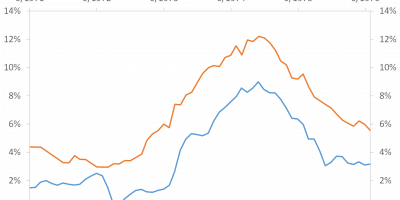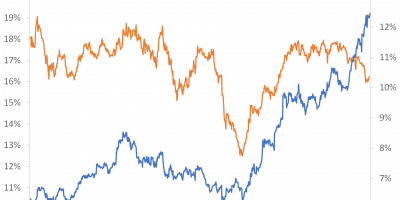Do asset purchases by central banks raise economic output and inflation? An interesting new paper finds an affirmative answer, but also – and this is the main point – that the size of the effect depends on whom you ask. If you ask central bankers, they will tell you that the effect of QE is large. If you ask independent academic researchers, they will tell you it is considerably smaller. This difference indicates that central-bank research on this topic might be biased. It also indicates that Quantitative Easing is probably not as effective as we are told.
One of the defining characteristics of financial markets since the financial crisis in 2008 is the use and influence of “unconventional policy tools” by central banks. As monetary policy rates have been close to zero, central banks have been unable to stimulate the economy via even lower interest rates. Instead, central banks have started purchasing financial assets, mainly government bonds. These alternative policy tools are labelled “asset purchases by central banks”, or simply “Quantitative Easing (QE)”.
Quantitative Easing increases the demand for government bonds, thereby raising their price and bringing down their yields. When yields on government bonds fall, other yields in the economy, such as yields on mortgage bonds, fall, too. This should promote economic activity and raise inflation, central banks argue.
Quantitative Easing is not uncontroversial, though. In several of my posts (link, link, and link), I have argued that it raises other asset prices in the economy, such as stock prices. Some fear that this induces bubble-like behavior in asset prices. Also, QE might distort signals from asset prices, causing unclear signals from prices about the underlying state of the economy and financial markets. In addition, by raising other asset prices, Quantitative Easing might contribute to increasing inequality, as financial assets are typically held by the already wealthy. On the other hand, if QE helps promoting economic activity, it helps reducing unemployment among low-income groups, which should reduce inequality, central banks argue in return (link). In the end, then, to justify Quantitative Easing, it should have a sizeable impact on inflation and output, outweighing the potentially negative effects on other parts of the economy.
Many papers have analyzed the effects of quantitative easing. A brand-new paper (link) summarizes these analyses and asks the question whether results are more positive when central bank economists analyze QE. Given that central banks influence public opinion, the latter question is important when we evaluate the most significant policy intervention during the last decade.
There are two reasons why I think this paper is particularly interesting. First, it summarizes research on QE in a neat way. It concludes that QE is effective, but not as effective as we are often told. Second, it emphasizes the importance of independent academic research. As the faculty representative on the Board of Directors at Copenhagen Business School, stressing the importance of academic research, I find this to be an important conclusion, too.
To avoid any misunderstandings about my own view, let me stress two things before getting to the results.
First, I believe that targeted central bank intervention can be useful. In my last post, I describe one monetary policy intervention that clearly fulfilled its goal (link). During a crisis, if markets are malfunctioning, there can be good reasons for policy interventions. On the other hand, I am skeptical towards the view that the advantages of endless asset purchases by central banks outside crisis periods outweigh their disadvantages. This paper indicates that QE is less powerful than central bankers tell us, lending some support to this view.
Second, my point here is not to say that central bank research is suspicious in general. On the contrary, I strongly recommend central banks to invest in economic research. I believe that better decisions are taken when based on solid academic analyses. So, central banks should be encouraged to invest in research, but their own evaluations of their own actions are probably not unbiased.
The study
Brian Fabo, Martina Jancokova, Elisabeth Kempf, and Lubos Pastor (link) study 54 analyses, written/published between 2010 and 2018, of the effects of quantitative easing in the US, the UK, and the Eurozone. 57% of the papers have been published in peer-reviewed journals. 60% of the authors are affiliated with central banks.
Lubos Pastor and co-authors collect estimates of the effect of QE on economic output and inflation across the 54 studies and report the average (and median) effects. They also investigate whether the reported effects are different if a study is conducted by central bank researchers.
Bias in central bank research
Pastor et al. list five reasons why central bank research might be biased (directly taken from the paper, page 2, here):
- ”First, the economist may worry that the nature of her findings could affect her employment status or rank. Is she less likely to get promoted if her findings dent the bank’s reputation? Could she get fired?”
- ”Second, the economist may be unsure whether her research will see the light of day. Bank management could in principle block the release of studies that find the bank’s own policy to be ineffective, or to have undesirable side effects.”
- ”Third, the economist may suffer from a confirmation bias (Nickerson (1998)). A central bank employee may believe a priori that the bank’s policies are effective, and she may select evidence supporting her prior.”
- ”Fourth, the economist may care about the bank’s reputation.”
- ”Finally, the economist may care about her own reputation if she is senior enough to have participated in the formation of the bank’s policy.”
The findings
The main findings of the paper are collected in this graph:

Pastor et al. report that a QE-program at its peak, i.e. when a QE program has its maximum effect, on average (across the 54 studies) raises GDP by 1.57% and the price level in the economy by 1.42%, as indicated by the blue columns in the graph (”Average all studies”). This seems to be relatively large effects, I would say.
Do these effects depend on the affiliations of researchers? Pastor and co-authors find that central-bank affiliated researchers report significantly larger effects. If counterfactually changing the share of central bank researchers in a study from 0% to 100%, the peak effect on output is estimated to be 0.723%-points larger and the peak effect on the price level 1.279%-points larger. I illustrate this in the figure above as the “Effect of CB authors”. Compared to the overall average effect, the effect of central-bank authorship is large. For the price level, going from 0% to 100% central-bank authorship almost corresponds to the total average estimated effect of QE on price levels across all 54 papers . In other words, if you think central bank estimates might be biased, the ”true” average effect of QE programs is considerably smaller than the estimated overall average effect.
Pastor and coauthors report the average point estimate of all papers and the additional effect of central bank affiliation, as indicated in the figure above. They do not report the average estimate from papers written by central bank authors, respectively written by academic authors. I asked Lubos Pastor about this. In private email correspondence with Lubos and Elisabeth Kempf, they inform me that papers written by central bank authors (defined as papers with at least one central bank author) estimate a 1.752% peak effect on output. Papers written by academics (defined as papers with zero central bank authors) find a considerably smaller effect, 0.996%. For inflation, the peak effect on output is 1.791% for papers written by central bank affiliated authors. Academics estimate a much smaller effect, only 0.545%. In spite of massive asset purchases (we are literally talking trillions of dollars, euros, and yen), the average effect on inflation is small, at 0.5%, academics report. Less than a third of what central bank affiliated researchers report.
As academics, we are not only interested in the size of the coefficients/effects, but also whether effects are statistically different from zero. Pastor and coauthors report a striking finding here. While all papers written by central bank researchers find that QE has a statistically significant effect on output/inflation, only 50% of papers written by independent academics find significant effects.
Finally, Pastor and co-authors note that the German central bank (the Bundesbank) has been particularly skeptical towards ECB QE. So, what happens if you look at researchers affiliated with the German central bank? Bundesbank researchers find much smaller effects of QE. In fact, Bundesbank researchers find an even smaller effect of QE on economic output than independent academics. Again, this indicates that the preferences of an institution seem to influence the conclusions of its researchers.
The paper presents additional analyses, such as looking more closely at the mechanisms at play, i.e. career concerns, involvement of management in research, and so on. Read the paper if you want to know more about this.
Conclusion
I think the paper by Brian Fabo, Martina Jancokova, Elisabeth Kempf, and Lubos Pastor is interesting also because it summarizes what the average effect of QE is, based on a large number of studies. Across more than 50 papers, the average maximum effect of QE on GDP and the price level is around 1.5%. This is useful information in itself.
Some papers are written by central bank researchers and some by independent academics. It seems reasonable to hypothesize that central bankers might have a tendency to view their own policies in a more favorable light. This is what Lubos and co-authors find. They report that the effect of having central bankers as authors of an analysis is almost as large as the average reported effect of QE on the price level itself. In private email correspondence, they also tell me that the average effect, estimated in academic papers, of QE on the price level is only 0.5%, i.e. very small, almost negligible. This is of course a controversial result. I predict it will generate intensive debate.
The fact that I discuss this paper here should not be taken to imply that I am skeptical towards central bank research in general. In fact, I am sure the quality of monetary policy decisions is improved when central bankers have access to the latest research. Also, I have no reason to believe that central bank research on other topics than monetary policy should be biased. But, when it comes to assessing their own actions, researchers in central banks might be subject to certain biases. It requires some guts to tell senior management that the trillions they have spent on quantitative easing probably has not been very effective. Instead, it might further your career if you paint a rosier picture. This is important to recognize.
I view the bottom line as follows: QE probably has some effect, but its effect is considerably smaller than we are told by central banks.


